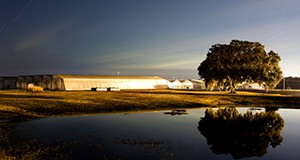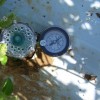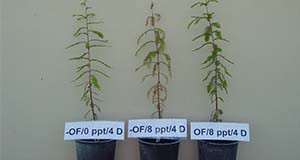Man-made activities can induce climate change and global sea-level rise, posing threats to the survival and growth of coastal vegetation in Florida. This three-page fact sheet explains how to ensure plant survival and facilitate the growth of coastal vegetation threatened by sea-level rise and the resulting oxygen deficiencies and saline stresses. Written by Guodong Liu, Yuncong Li, Kimberly Moore, Kim Gabel, Lei Wu, and Rafael Muñoz-Carpena, and published by the Horticultural Sciences Department.
http://edis.ifas.ufl.edu/hs1280
Tag: Rafael Munoz-Carpena
What Else Can Surface Water Buffer Systems Do?: Exploring Multiple Ecosystem Services
 As society confronts the consequences of global warming, deteriorating water quality, and impoverished biodiversity, there is a growing urgency to develop and expand water buffers' multifunctional ecosystem services. However, limited information is available on other potential co-benefits associated with the use of buffers, particularly VFSs. This 5-page fact sheet provides information on buffers' multiple ecosystem benefits, such as niche products production, carbon sequestration, and flood risk mitigation, as well as recommendations on future research needs necessary to enhance multiple ecosystem services and benefits of buffers. Written by Lei Wu, Rafael Muñoz-Carpena, and Yuncong Li, and published by the UF Department of Soil and Water Science, November 2015.
As society confronts the consequences of global warming, deteriorating water quality, and impoverished biodiversity, there is a growing urgency to develop and expand water buffers' multifunctional ecosystem services. However, limited information is available on other potential co-benefits associated with the use of buffers, particularly VFSs. This 5-page fact sheet provides information on buffers' multiple ecosystem benefits, such as niche products production, carbon sequestration, and flood risk mitigation, as well as recommendations on future research needs necessary to enhance multiple ecosystem services and benefits of buffers. Written by Lei Wu, Rafael Muñoz-Carpena, and Yuncong Li, and published by the UF Department of Soil and Water Science, November 2015.
http://edis.ifas.ufl.edu/ss647
Vegetative Filter Strips: A Best Management Practice for Controlling Nonpoint Source Pollution
 Increasing numbers of pollutants have been observed in natural water systems. As awareness of agricultural sources of water pollution has grown, Best Management Practices (BMPs) have been specifically designed to address agricultural water pollutants and protect water quality. This 4-page fact sheet introduces one of the BMPs, Vegetative Filter Strips (VFSs), which efficiently control nonpoint pollution such as sediments, nutrients, and pesticides. The publication covers primary functions, key design factors, and maintenance of VFSs. Written by Lei Wu, Rafael Muñoz-Carpena, and Yuncong Li, and published by the UF Department of Soil and Water Science, October 2015.
Increasing numbers of pollutants have been observed in natural water systems. As awareness of agricultural sources of water pollution has grown, Best Management Practices (BMPs) have been specifically designed to address agricultural water pollutants and protect water quality. This 4-page fact sheet introduces one of the BMPs, Vegetative Filter Strips (VFSs), which efficiently control nonpoint pollution such as sediments, nutrients, and pesticides. The publication covers primary functions, key design factors, and maintenance of VFSs. Written by Lei Wu, Rafael Muñoz-Carpena, and Yuncong Li, and published by the UF Department of Soil and Water Science, October 2015.
http://edis.ifas.ufl.edu/ss646
Using Tensiometers for Vegetable Irrigation Scheduling in Miami-Dade County (ABE326/TR015)
 A tensiometer is a simple and relatively inexpensive tool that can be used to schedule irrigation in Miami-Dade County vegetable crops. Tensiometers continuously measure soil water potential or tension. If the tension in the soil is high, plants have to use more energy to extract soil water. If tension in the soil is low, then plants have lower energy requirements to extract soil water. This 6-page fact sheet was written by Kati W. Migliaccio, Teresa Olczyk, Yuncong Li, Rafael Muñoz-Carpena, and Tina Dispenza, and published by the UF Department of Agricultural and Biological Engineering, December 2012.
A tensiometer is a simple and relatively inexpensive tool that can be used to schedule irrigation in Miami-Dade County vegetable crops. Tensiometers continuously measure soil water potential or tension. If the tension in the soil is high, plants have to use more energy to extract soil water. If tension in the soil is low, then plants have lower energy requirements to extract soil water. This 6-page fact sheet was written by Kati W. Migliaccio, Teresa Olczyk, Yuncong Li, Rafael Muñoz-Carpena, and Tina Dispenza, and published by the UF Department of Agricultural and Biological Engineering, December 2012.
http://edis.ifas.ufl.edu/tr015
ABE368/AE396 South Florida Tropical Fruit Grower Perspectives: Water Conservation Management Practices
Revised! ABE368, a 6-page fact sheet by Kati W. Migliaccio, Jonathan H. Crane, Edward Evans, Bruce Schaffer, Yuncong Li, and Rafael Muñoz-Carpena, presents results of fruit grower responses from a survey designed to assess changing views of agricultural producers in Miami-Dade county from 2006 to 2009 regarding water quantity and quality management practices — methods, demographics, water quality and quantity opinions concerning lifestyle, agriculture, and best management practices (BMPs). Includes references. Published by the UF Department of Agricultural and Biological Engineering, November 2009.
http://edis.ifas.ufl.edu/AE396
